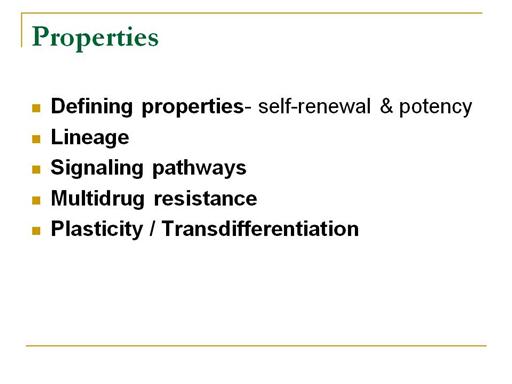| front |1 |2 |3 |4 |5 |6 |7 |8 |9 |10 |11 |12 |13 |14 |15 |16 |17 |18 |19 |20 |21 |22 |23 |24 |25 |26 |27 |28 |29 |30 |31 |review |
 |
Properties of adult stem cells 2.1.1 Defining properties Self-renewal which is the ability to go through numerous cycles of cell division while maintaining the undifferentiated state. Multipotency or multidifferentiative potential which is the ability to generate progeny of several distinct cell types, (for example glial cells and neurons) as opposed to unipotency which is the term for cells that are restricted to producing a single-cell type. These properties can be shown with relative ease in vitro using methods such as clonogenic assays, where the progeny of a single cell is characterized, however, it is known that in vitro cell culture conditions can alter the behavior of cells. Proving that a particular subpopulation of cells possesses stem cell properties in vivo is challenging. 2.1.2 Lineage To ensure self-renewal, stem cells undergo two types of cell division,one is Symmetric division gives rise to two identical daughter cells, both endowed with stem cell properties, whereas asymmetric division produces only one stem cell and a progenitor cells with limited self-renewal potential. Asymmetric division is the process of a cell splitting into another cell and an essential cell fat, or a lipid , this lipid will bond to a free cell and reproduce. Progenitors can go through several rounds of cell division before finally differentiating into a mature cell. The molecular distinction between symmetric and asymmetric divisions lies in differential segregation of cell membrane proteins (such as receptors) between the daughter cells. 2.1.3 Signaling pathways Adult stem cell research has been focused on uncovering the general molecular mechanisms that control their self-renewal and differentiation. Eg: Bmi-1 , Notch , Wnt. These developmental pathways are also strongly implicated as stem cell regulators.(Beachy et al,2004). 2.1.4 Multidrug resistance Adult stem cells express transporters of the ATP-binding cassette family that actively pump a diversity of organic molecules out of the cell.(Chaudhary and Roninson,1991). Many pharmaceuticals are exported by these transporters conferring multidrug resistance onto the cell. This complicates the design of drugs, for instance neural stem cells targeted therapies for the treatment of clinical depression. 2.1.5 Plasticity Under special conditions tissue-specific adult stem cells can generate a whole spectrum of cell types of other tissues, even crossing germ layers.(Filip et al,2004). This phenomenon is referred to as stem cell transdifferentiation or plasticity. It can be induced by modifying the growth medium when stem cells are cultured in vitro or transplanting them to an organ of the body different from the one they were originally isolated from. |